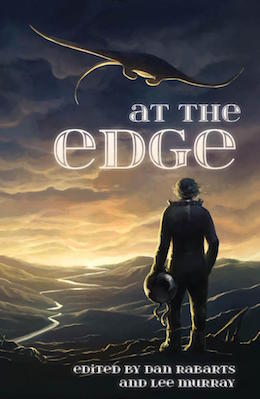At the Edge, edited by Dan Rabarts and Lee Murray and released by Paper Road Press, has a specific, two-pronged task at hand: to give the spotlight to writers from New Zealand and Australia and to thrill readers with stories of dark science fiction and horror. The anthology takes its titular concept and runs with it to “the edge of civilisation, the fringe of reason and the border of reality”, according to the anthology’s official Kickstarter page.
I’ve had this anthology on my radar, since I’m not as familiar with the SF/F and speculative writing scenes in Australia and New Zealand as I’d like to be. Having finished At the Edge, I find myself unsure as to how to formulate my thoughts. The intent here is clearly to give readers a crazy, wild ride through the local literary ecosystem. What happens along the way is that the theme stretches greatly to accommodate stories that either don’t tonally fit with what you’d expect from the description (like Octavia Cade’s “Responsibility”) or flirt with the speculative while remaining coy (Shell Child’s “Narco”). At the same time, Cade’s light story, which revolves around a chicken, made for one of the most memorable moments in At the Edge.
Rabarts and Murray have selected some stunning stories—ones I continue to think about weeks after I finished reading. Yet, At the Edge is unfocused and choppy in the sense that the stories don’t come together to build a bigger narrative or create a unified vision—the reason I fell into reading themed anthologies in the first place. The stories here exist separately as cli-fi, space opera, bleak post-apocalyptic worlds, body horror, and the supernatural without a connecting thread, other than geography, to weave them together into something bigger or more satisfying.
That’s not to say readers won’t find good writing. A.C. Buchanan’s “And Still the Forests Grow though We are Gone” portrays man-made natural disasters in an ideal green and sustainable future, caused by the last convulsions of a struggling community to survive. It’s a standout: a powerful story with layered depths and honest examination of the human psyche in those critical moments when we’re pushed to our limits. In the eerie “In Sacrifice We Hope”, Keira McKenzie slowly unravels the monstrous horrors pollution can beget. These implications are also developed with gripping, horrific results in Paul Mannering’s “The Island at the End of the World”.
In Jodi Cleghorn’s “The Leaves No Longer Fall”, which is rooted in a more conventional approach to climate disasters, there’s still hope—though at what cost? Taking a different tack, J.C. Hart places Papatūānuku, the Māori Mother Earth goddess, at the heart of the annihilation that humankind faces in “Hope Lies North”. The fear of environmental catastrophes is palpable, as these stories don’t pull punches, but instead plunge the knife to the bone and press against the bone. How high is the cost of survival? When do we know we’ve been beaten?
Outside this theme, there’s plenty else to grab your attention. A.J. Fitzwater’s “Splintr” is a unique piece—a straightforward time loop scenario elevated in complexity and nuance by the radical changes in style that accompany each repetition. It’s straightforward science fiction, which arrives at an aesthetic not dissimilar to H.R. Giger’s art. David Stevens transforms the countryside into a terrifying ecological nightmare in “Crop Rotation“, a story that makes disgust its bread and butter. Martin Livings turns to a dysfunctional family in “Boxing Day” to teach readers all about the corruption that vengeance engenders. In “Seven Excerpts from Season One,” David Versace uses the premise of video-editing a web series as the vehicle for a bloody haunting.
With 23 stories in total, variation in quality is assured. I encountered stories that, although work in the sense that they earn their endings, didn’t make a lasting impression. Then there are E.G. Wilson’s “12-36” and Tom Dullemond’s “One Life, No Respawns”, which I pair together as both stories each take on a curious concept, but in the end read to me as incomplete. The decision to split Phillip Mann’s “The Architect” into two halves, published at the opposite ends of the anthology, baffles me; not that keeping it intact would have improved my reading, as I found the story a tad too long and the writing flavorless throughout the narrative, which is focused on the solitary work and life of the protagonist. I have stylistic reservations about Richard Barnes’ “The Great and True Journey” and its attempt at ardency, which results in generally over-the-top prose and dialogue.
Based on your personal tastes, sweet spots, and deal-breakers, your mileage may vary, but either way At the Edge provokes a reaction, and it has given me at least ten new authors to follow with interest (which was certainly part of Rabarts and Murray’s intent, in the first place). I felt rewarded by the opportunity to explore the particular geography of New Zealand and Australia, as most authors sought to ground their narratives in the existing places they call home, but that to me are fascinatingly unfamiliar. The few mentions of Māori mythology have kindled my desire to further extend my reading, and ultimately prove that speculative fiction can definitely afford to take more breaks from all the familiar cities and landscapes we’ve come to expect as locations and lead us on to less frequently visited frontiers.
At the Edge opens the door and points the way.
At the Edge is available from Paper Road Press.
Haralambi Markov is a Bulgarian critic, editor, and writer of things weird and fantastic. A Clarion 2014 graduate, he enjoys fairy tales, obscure folkloric monsters, and inventing death rituals (for his stories, not his neighbors…usually). He blogs at The Alternative Typewriter and tweets @HaralambiMarkov. His stories have appeared in The Weird Fiction Review, Electric Velocipede, Tor.com, Stories for Chip, The Apex Book of World SF and are slated to appear in Genius Loci, Uncanny and Upside Down: Inverted Tropes in Storytelling. He’s currently working on a novel.










